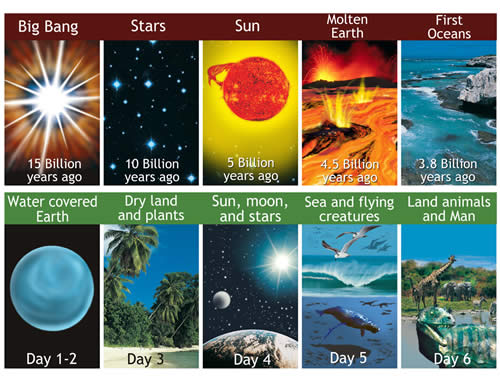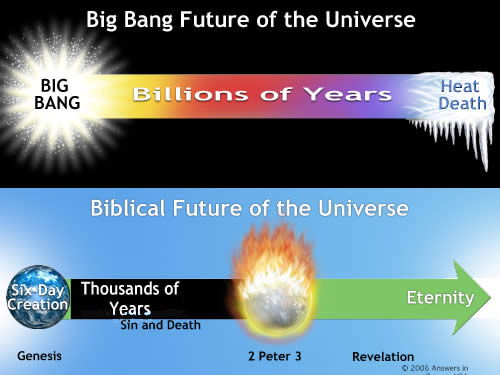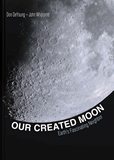
Chapter 5
Does the Big Bang Fit with the Bible?
The “big bang” story aims to explain the universe’s origin without God and simultaneously fails to align with either the Bible & established scientific findings.
The “big bang” is a story about how the universe came into existence. It proposes that billions of years ago the universe began in a tiny, infinitely hot and dense point called a singularity. This singularity supposedly contained not only all the mass and energy that would become everything we see today, but also “space” itself. According to the story, the singularity rapidly expanded, spreading out the energy and space.

It is supposed that over vast periods of time, the energy from the big bang cooled down as the universe expanded. Some of it turned into matter—hydrogen and helium gas. These gases collapsed to form stars and galaxies of stars. Some of the stars created the heavier elements in their core and then exploded, distributing these elements into space. Some of the heavier elements allegedly began to stick together and formed the earth and other planets.
This story of origins is entirely fiction. But sadly, many people claim to believe the big-bang model. It is particularly distressing that many professing Christians have been taken in by the big bang, perhaps without realizing its atheistic underpinnings. They have chosen to reinterpret the plain teachings of Scripture in an attempt to make it mesh with secular beliefs about origins.
Secular Compromises
There are several reasons why we cannot just add the big bang to the Bible. Ultimately, the big bang is a secular story of origins. When first proposed, it was an attempt to explain how the universe could have been created without God. Really, it is an alternative to the Bible, so it makes no sense to try to “add” it to the Bible. Let us examine some of the profound differences between the Bible and the secular big-bang view of origins.
The Bible teaches that God created the universe in six days (Genesis 1; Exodus 20:11). It is clear from the context in Genesis that these were days in the ordinary sense (i.e., 24-hour days) since they are bounded by evening and morning and occur in an ordered list (second day, third day, etc.). Conversely, the big bang teaches the universe has evolved over billions of years.

The Bible says that earth was created before the stars and that trees were created before the sun.1 However, the big-bang view teaches the exact opposite. The Bible tells us that the earth was created as a paradise; the secular model teaches it was created as a molten blob. The big bang and the Bible certainly do not agree about the past.
Many people don’t realize that the big bang is a story not only about the past but also about the future. The most popular version of the big bang teaches that the universe will expand forever and eventually run out of usable energy. According to the story, it will remain that way forever in a state that astronomers call “heat death.”2 But the Bible teaches that the world will be judged and remade. Paradise will be restored. The big bang denies this crucial biblical teaching.

Scientific Problems with the Big Bang
The big bang also has a number of scientific problems. Big-bang supporters are forced to accept on “blind faith” a number of notions that are completely inconsistent with real observational science. Let’s explore some of the inconsistencies between the big-bang story and the real universe.
Missing Monopoles
Most people know something about magnets—like the kind found in a compass or the kind that sticks to a refrigerator. We often say that magnets have two “poles”—a north pole and a south pole. Poles that are alike will repel each other, while opposites attract. A “monopole” is a hypothetical massive particle that is just like a magnet but has only one pole. So a monopole would have either a north pole or a south pole, but not both.
Particle physicists claim that many magnetic monopoles should have been created in the high temperature conditions of the big bang. Since monopoles are stable, they should have lasted to this day. Yet, despite considerable search efforts, monopoles have not been found. Where are the monopoles? The fact that we don’t find any monopoles suggests that the universe never was that hot. This indicates that there never was a big bang, but it is perfectly consistent with the Bible’s account of creation, since the universe did not start infinitely hot.
The Flatness Problem

Another serious challenge to the big-bang model is called the flatness problem. The expansion rate of the universe appears to be very finely balanced with the force of gravity; this condition is known as flat. If the universe were the accidental by-product of a big bang, it is difficult to imagine how such a fantastic coincidence could occur. Big-bang cosmology cannot explain why the matter density in the universe isn’t greater, causing it to collapse upon itself (closed universe), or less, causing the universe to rapidly fly apart (open universe).
The problem is even more severe when we extrapolate into the past. Since any deviation from perfect flatness tends to increase as time moves forward, it logically follows that the universe must have been even more precisely balanced in the past than it is today. Thus, at the moment of the big bang, the universe would have been virtually flat to an extremely high precision. This must have been the case (assuming the big bang), despite the fact that the laws of physics allow for an infinite range of values. This is a coincidence that stretches credulity to the breaking point. Of course, in the creation model, “balance” is expected since the Lord has fine-tuned the universe for life.
Inflating the Complexities
Many secular astronomers have come up with an idea called “inflation” in an attempt to address the flatness and monopole problems (as well as other problems not addressed in detail here, such as the horizon problem). Inflation proposes that the universe temporarily went through a period of accelerated expansion. Amazingly, there is no real supporting evidence for inflation; it appears to be nothing more than an unsubstantiated conjecture—much like the big bang itself. Moreover, the inflation idea has difficulties of its own, such as what would start it and how it would stop smoothly. In addition, other problems with the big bang are not solved, even if inflation were true. These are examined below.
Where Is the Antimatter?
Consider the “baryon number problem.” Recall that the big bang supposes that matter (hydrogen and helium gas) was created from energy as the universe expanded. However, experimental physics tells us that whenever matter is created from energy, such a reaction also produces antimatter. Antimatter has similar properties to matter, except the charges of the particles are reversed. (So whereas a proton has a positive charge, an antiproton has a negative charge.) Any reaction where energy is transformed into matter produces an exactly equal amount of antimatter; there are no known exceptions.
The big bang...should have produced exactly equal amounts of matter and antimatter, and that should be what we see today. But we do not.
The big bang (which has no matter to begin with, only energy) should have produced exactly equal amounts of matter and antimatter, and that should be what we see today. But we do not. The visible universe is comprised almost entirely of matter—with only trace amounts of antimatter anywhere.
This devastating problem for the big bang is actually consistent with biblical creation; it is a design feature. God created the universe to be essentially matter only—and it’s a good thing He did. When matter and antimatter come together, they violently destroy each other. If the universe had equal amounts of matter and antimatter (as the big bang requires), life would not be possible.
Missing Population III Stars
The big-bang model by itself can only account for the existence of the three lightest elements (hydrogen, helium, and trace amounts of lithium). This leaves about 90 or so of the other naturally occurring elements to be explained. Since the conditions in the big bang are not right to form these heavier elements (as big-bang supporters readily concede), secular astronomers believe that stars have produced the remaining elements by nuclear fusion in the core. This is thought to occur in the final stages of a massive star as it explodes (a supernova). The explosion then distributes the heavier elements into space. Second- and third-generation stars are thus “contaminated” with small amounts of these heavier elements.
If this story were true, then the first stars would have been comprised of only the three lightest elements (since these would have been the only elements in existence initially). Some such stars3 should still be around today since their potential life span is calculated to exceed the (big bang) age of the universe. Such stars would be called “Population III” stars.4 Amazingly (to those who believe in the big bang), Population III stars have not been found anywhere. All known stars have at least trace amounts of heavy elements in them. It is amazing to think that our galaxy alone is estimated to have over 100 billion stars in it, yet not one star has been discovered that is comprised of only the three lightest elements.
The Collapse of the Big Bang
With all the problems listed above, as well as many others too numerous to include, it is not surprising that quite a few secular astronomers are beginning to abandon the big bang. Although it is still the dominant model at present, increasing numbers of physicists and astronomers are realizing that the big bang simply is not a good explanation of how the universe began. In the May 22, 2004, issue of New Scientist, there appeared an open letter to the scientific community written primarily by secular scientists5 who challenge the big bang. These scientists pointed out that the copious arbitrary assumptions and the lack of successful big-bang predictions challenge the legitimacy of the model. Among other things, they state:
The big bang today relies on a growing number of hypothetical entities, things that we have never observed—inflation, dark matter and dark energy are the most prominent examples. Without them, there would be a fatal contradiction between the observations made by astronomers and the predictions of the big bang theory. In no other field of physics would this continual recourse to new hypothetical objects be accepted as a way of bridging the gap between theory and observation. It would, at the least, raise serious questions about the validity of the underlying theory.6
This statement has since been signed by hundreds of other scientists and professors at various institutions. The big bang seems to be losing considerable popularity. Secular scientists are increasingly rejecting the big bang in favor of other models. If the big bang is abandoned, what will happen to all the Christians who compromised and claimed that the Bible is compatible with the big bang? What will they say? Will they claim that the Bible actually does not teach the big bang, but instead that it teaches the latest secular model? Secular models come and go, but God’s Word does not need to be changed because God got it exactly right the first time.
Conclusion
The big bang has many scientific problems. These problems are symptomatic of the underlying incorrect worldview. The big bang erroneously assumes that the universe was not supernaturally created, but that it came about by natural processes billions of years ago. However, reality does not line up with this notion. Biblical creation explains the evidence in a more straightforward way without the ubiquitous speculations prevalent in secular models. But ultimately, the best reason to reject the big bang is that it goes against what the Creator of the universe himself has taught: “In the beginning God created the heaven and the earth” (Genesis 1:1).
The New Answers Book 2
In The New Answers Book 2 you’ll find 31 more great answers to big questions for the Christian life.
Read Online Buy BookFootnotes
- The sun and stars were made on Day 4 (Genesis 1:14–19). The earth was made on Day 1 (Genesis 1:1–5). Trees were made on Day 3 (Genesis 1:11–13).
- Despite the name heat death, the universe would actually be exceedingly cold.
- Small (red main sequence) stars do not use up their fuel quickly. These stars theoretically have enough fuel to last significantly longer than the estimated age of the (big bang) universe.
- If a star has a very small amount of heavy elements, it is called a “Population II” star. Population II stars exist primarily in the central bulge of spiral galaxies, in globular star clusters, and in elliptical galaxies. If a star has a relatively large amount of heavy elements (like the sun), it is called “Population I.” These stars exist primarily in the arms of spiral galaxies. The (hypothetical) Population III star would have no heavy elements at all.
- The alternatives to the big bang that these scientists had suggested are equally unbiblical. These included a steady-state theory and plasma cosmology.
- E. Lerner et al., An open letter to the scientific community, New Scientist 182(2448):20, May 22, 2004. Available online at www.cosmologystatement.org.
Recommended Resources

Answers in Genesis is an apologetics ministry, dedicated to helping Christians defend their faith and proclaim the good news of Jesus Christ.
- Customer Service 800.778.3390
- Available Monday–Friday | 9 AM–5 PM ET
- © 2026 Answers in Genesis


